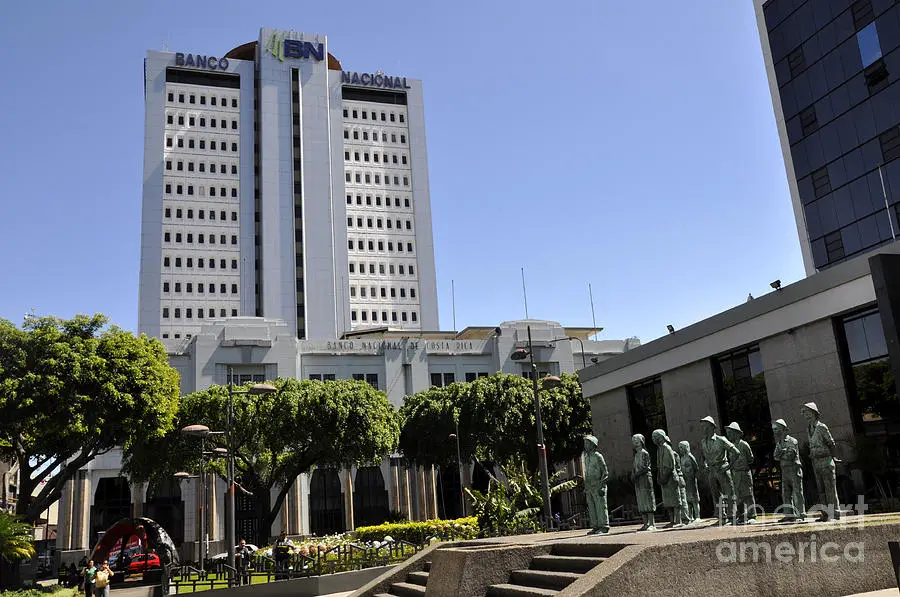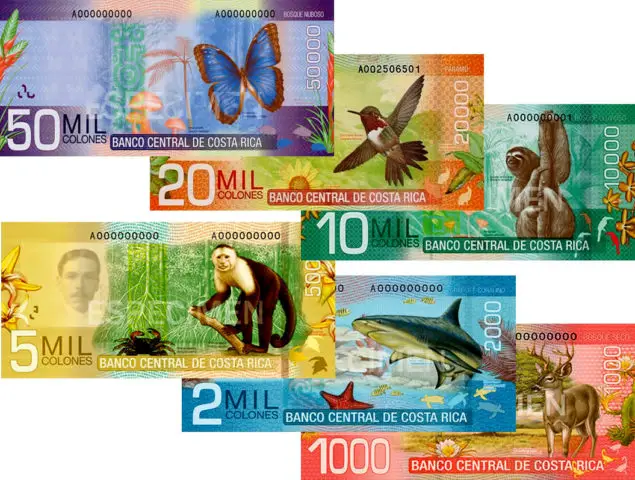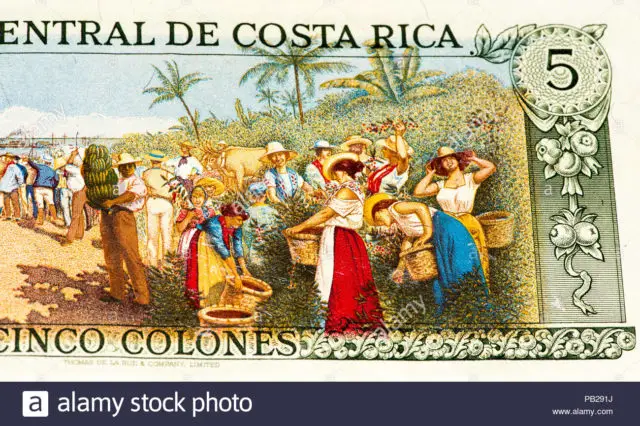The National Bank (BNCR), belonging to the Costa Rican State, is the largest Public Bank in the Country; it was founded on October 9, 1914, under the name of the International Bank of Costa Rica. In 1936 the name was changed to the National Bank of Costa Rica and since then it has established itself as a true development bank with a transcendent projection in the economic, social and financial life of the country.

There is not a single Costa Rican who, in one way or another, has not benefited from the actions of the National Bank. The National Bank has a network of more than 160 offices, 467 ATMs nationwide and more than 5900 employees. It has a 49% interest in the International Bank of Costa Rica Limites (BICSA), an entity incorporated in the Republic of Panama. It owns 100% of the shares of BNCR Valores (Stock Market), BNCR Vital (Pension Fund Operator), BNCR SAFI (Investment Funds), and BNCR Corredora de Seguros (Insurance brokerage).
More than 3000 commercial establishments affiliated with the BNCR Services system, can provide more than 1200 payment options with public and private companies, and offer the possibility of making cash withdrawals and payment of credit cards and credit operations.
Historical review.
The National Bank was born in 1914, at the beginning of the administration of President Alfredo González Flores. At that time the First World War was also beginning. Anticipating a possible contraction of exports, the Government required stimulating domestic demand. For this, it was necessary to put cash in the hands of Costa Rican families, but at the time the issuance of currency was in the hands of private banks. Therefore, President González Flores decided to create the first State Bank, which originally was given the name of the International Bank of Costa Rica.
The International Bank of Costa Rica opened its doors on November 3, 1914, and immediately began issuing banknotes of ¢ 5, ¢ 10, ¢ 20, ¢ 50 and ¢ 100, notes that had already been created and appeared with the date of November 1, 1914. By March 1915, the Bank already had received ¢ 675,000 in deposits and granted ¢ 1,115,000 in loans, of which one third were mortgages. By that year there were already 27 Rural Agricultural Credit Boards, which together lent ¢ 200,000. At that time there was no formal separation between the different management functions in the Bank. Both were in the position of Chairman of the Board of Directors, which was occupied by Walter Fiel Spencer from 1914 to 1917, and by Juan Bautista Quiroz from 1917 to 1919. Juan Rafael Chacón Paut was President-Director from 1919 to 1934. During his tenure, the International Bank became the sole issuer (as of 1921), administrator of the Conversion Fund created to stabilize the exchange rate and after the Change Control Board (1932). Julio Peña Morúa was the last President-Director of the International Bank and the first Manager of the National Bank. His management lasted for almost 15 years (1934-1949).
Don Julio Peña Morua was President-Director when the 1936 reform came about, which transformed the International Bank into three departments (Issuer, Commercial and Mortgage), consolidating in its end-results, under the name of the National Bank of Costa Rica.
Don Elías Quiroz Salazar who served as General Manager for 22 years (1950-1972), managed to extend banking services with the largest network of branches, agencies, auxiliary savings banks and warehouses throughout the country. In 1950, the issuing department of the National Bank became the “Central Bank of Costa Rica”.
As of 1972, the appointment of the
general managers of the Bank tended to respond to changes in management styles
of the National Executive Branch. Thus, Manuel Naranjo Coto was a general
manager from 1972 to 1977; Porfirio Morera Batres from 1978 to 1982; Rolando
Ramírez Paniagua from 1983 to 1986; Luis Alberto Carranza of 1986
to 1990 and again from 1995 to 1997; Arturo Cuevillas León from 1990 to 1992
and Omar Garro Vargas from 1992 to 1995.
This trend changed after the appointment of William Hayden Quintero, who served as general manager for twelve years (1997-2009). Under his administration, decentralization was promoted with the creation of six regional banks and three subsidiaries. It is widely known that institutions such as the National Production Council, the Agrarian Development Institute, the National Housing, and Urban Development Institute and the National Cooperative Development Institute were born from the National Bank.
The current location of the headquarters of the National Bank in San José is the same as in 1914. Previously there was located the National Mint, which was demolished in 1912. The First National Bank building was constructed in 1914 and was replaced in 1936 with the one that currently exists there. Next to this one the 19-story tower that currently occupies the headquarters of the Bank was built in 1982, it was the tallest habitable building in the country until 2011 with 80 meters and 22 floors counting the last floor, the roof, and the helipad.
The National Bank of Costa Rica (BNCR), is the largest commercial bank in Costa Rica, and the second-largest in Central America by assets, being number 70 in the list of the largest banks in Latin America. The perspective of the rating is stable, at an international level, given that it has the state guarantee, the BNCR obtained the same rating that the Government of Costa Rica has (BB +).

BNCR Mission and Vision: Improving the quality of life of as many people as possible, offering excellent financial services that foster the sustainable creation of wealth, and to be the best bank in the country in regards to customer service.
A brief history of banking and money in Costa Rica.
The history of paper money in Costa Rica began in 1839, when the Head of State, Braulio Carrillo, authorized the issuance of 30,000 pesos, in vouchers of 5 and 10 pesos, to facilitate the payment to public employees, thus begins the first stage of the history of currency in the country, which arose linked to the need to have an element that can be used as a measure of exchange or retribution, given the shortage of metallic currency that existed at that time.
In 1858, the first bank was founded in Costa Rica, called the Costa Rican National Bank, that issued 1, 2, 10 and 20 peso bills, of the A and B series. With this institution, a second stage begins in the issuance of paper money, in which banks began to implement the existence of coins. The monetary reform of 1896 established the colon as currency, and the Bank Law of 1900 allowed any bank with a capital of one million colonies to have the capacity to issue notes. In 1914 the International Bank was created, as the issuing bank of the National State; in 1921 it was designated as the sole issuer, and the power to issue banknotes was taken away from other private banks.
In 1950 the Central Bank of Costa Rica was founded, as the only authorized body for the issuance of currency, using as a basis the formulas of the National Bank, with the impression of Banknotes stating “Central Bank of Costa Rica Provisional Series”.
Cultural heritage.

The Central Bank of Costa Rica concerned with cultural and archaeological heritage formed the pre-Columbian gold collection between 1950 and 1974. At the same time, it promoted its numismatic collection and began acquiring national works of art. Initially, a public gallery was created in the Bank’s main building, but when the collection grew, it was decided to build a Museum, exclusively designed for hosting these collections, to direct its cultural work more efficiently. Created on November 10, 1993, the “Foundation to Manage the Museums of the Central Bank” is created. Since then, a qualified interdisciplinary group of professionals works hard to offer new and varied exhibitions to the public that visit the institution. Research, technical publications, activities, workshops, and concerts for the public are also part of the offer of this Cultural Center that always seeks excellence through education.

